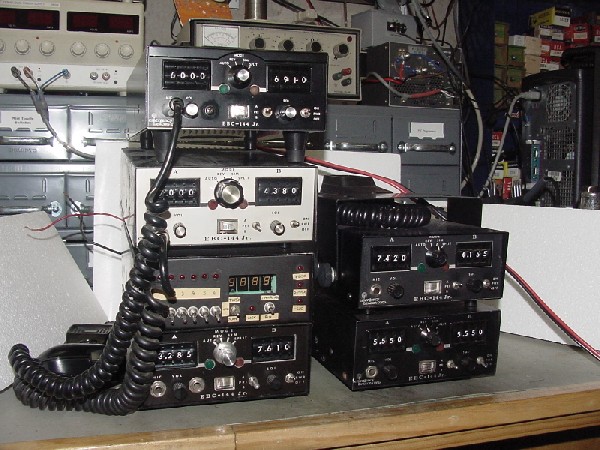| Emergency Beacon
Corp. The EBC-144Jr and other EBC Products Addendum |
| June 2012 (Updated
3-Jan-2022) After writing my original page on the Emergency Beacon 2M FM transceivers I have had the opportunity to be in contact and learn additional information from others relating to the company and their radios. As a result I have created this addendum page. Since the original page I have added three more EBC-144Jr's, for a total of five, to my collection as shown below. Addendum's
1.
Does the big brother EBC-144
Exist? From the many emails I've
received from people who were directly
associated with the EBC company
or were on the waiting lists to
receive the EBC-144 it appears that
the EBC-144 was never
produced! Any
pictures of the EBC-144 were merely an
engineering mock-up and no
record of its physical existence have
been found as of this writing.
2. How many EBC-144Jr's were built? Through a review of the serial numbers submitted so far, a rather limited list, it appears that over 600 EBC-144Jr's could have been produced. See the Serial Number analysis below. 3. What are the major production changes made to the EBC-144Jr? There appears to be one major revision done to the EBC-144Jr during its brief manufacturing time resulting in two major versions. I'll refer to them as the early and late versions and it appears they can be distinguished by their serial number syntax described later. Early Version - All internal chassis are bare brass. - The receiver PCB is an early version without a socketed ribbon cable attached to the board top. - The rear of the radio is one large heat-sink that is milled out for the antenna connection, a TO-3 voltage regulator and the studs for the amplifier final transistors. Late Version - All internal chassis are Zinc Chromate plated (silver colored). - The receiver PCB is the later version with a socketed ribbon cable attached to the board top. - The rear of the radio has a small heat sink that is used for the two output transistor studs. 4. The EBC-144Jr Serial Numbering Syntax. There appears to have been two different syntax's used for the EBC-144Jr serial numbers and they also appear to be related to the change from the early version and late version of the radio. Early Radio Serial Numbers (1974 through early 1975) These radios use the serial number YYWW*** syntax. Where YY is the last two digits of the year and WW is the two digits representing the week of manufacture. The *** is simply a sequential three digit number. Thus 7446116 would be a radio made in 1974 during the 46th week (November) and was the 116th overall manufactured under this syntax. The highest serial number we have recorded is a 751334*. The last digit could not be read, but it appears this radio is in the 340 range. Late Radio Serial Numbers (Early 1975 to ?) These radios use the serial number YX*** syntax. Where the Y is the last digit of the year and the *** is again a sequential three digit number. The X does not appear to be part of a sequential number and so far only have one example of a 0 and several with a 1 in that position. Thus 51049 is a radio manufactured in 1975 and was the 49th radio manufactured. Notice with this new numbering syntax we loose the ability to date a radio to a specific week within the year. The highest serial number recorded using this syntax is 51322 so it appears at least 322 radios were made using this sequence. I also assume that they restarted the sequential number when they went to the new format since we have a couple of radios using numbers below 100 and it is well established that they went over 300 using the old serial number syntax scheme. With my current recording of serial numbers both the early and late versions of the serial number syntax had over 300 radios in their sequences. Thus, earlier we could predict that over 600 radios were produced. 5. Why the wire nut on the 12VDC power to the meter light bulb? It has not yet been established why they used a standard electrical wire nut to wire in the 12VDC light bulb to illuminate the meter. However, unless the user has modified the radio and removed the wire nut, as I did, it appears this was a standard practice on all EBC-144Jr's. 6. When was the light bulbs added above the frequency entry switches? This I'm still not sure of. However, it does appear they added the new cover that has the front flaps during the late version manufacturing, but strangely not on all of them. We do have recorded that radio number 51284, a high numbered late version, does not have the illuminated switches. Yet as early as 51049 does have them illuminated. More serial numbers and contact with ex-EBC personnel will probably be needed to resolve this issue. Perhaps owners could also return their radios to EBC to have this illumination added. 7. What are some other variations on the EBC-144Jr? - I own one example of a silver front paneled radio (see picture above). The radio has no serial number, but I have a recorded second one with S/N 50111. With this later S/N this would put the silver faced units later in the manufacturing cycle. - More will be added here as we gather more examples of radios that remain. 8. Where can I get documents for the EBC-144Jr? Contact me  |
